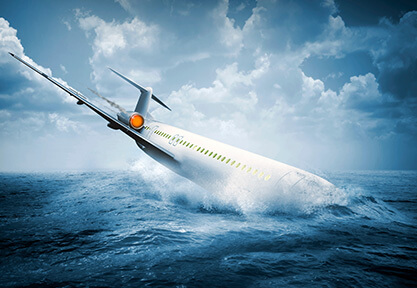TORTS – AIRCRAFT ACCIDENT – PERSONAL INJURY – COMPENSATION – STATUTORY CONSTRUCTION – S.9E CIVIL AVIATION (CARRIERS LIABILITY ACT) 1959 – ARTICLE 17 MONTREAL CONVENTION 1999 – WHETHER PSYCHOLOGICAL INJURY IS A COMPENSABLE BODILY INJURY
Air crash during international carriage – physical and psychological injuries including PTSD – does construction of s.9E allow for compensation for ‘personal injuries’ – is PTSD a ‘bodily injury’ under Article 17 – Casey v Pel-Air Aviation Pty Ltd
[2015] NSWSC 566
DECISION DATE: 15 MAY 2015
SUPREME COURT OF NEW SOUTH WALES
BEFORE: SCHMIDT J
SOLICITORS: EVERETT EVANS (PLAINTIFF)
GSG LEGAL (DEFENDANT)
Background
The Plaintiff, Ms Karen Casey, was a nurse onboard a care flight, repatriating a seriously ill patient from Samoa to Melbourne. The aircraft was operated by the Defendant, Pel-Air Aviation Pty Ltd.
The plane was due to refuel at Norfolk Island but was unable to land due to bad weather. After four aborted landings, the plane crashed into the sea after running out of fuel.
Remarkably everyone on board the flight survived the crash and was rescued. The Plaintiff sustained serious injuries, including damage to 7 teeth, neural irritation, disc bulges at C3/C4 and C4/5, injury to the facet joint at C2/3, injury to the right knee, major depressive disorder, anxiety disorder, chronic pain, complex regional pain syndrome, and Post Traumatic Stress Disorder (PTSD).
Liability was admitted by the Defendant, however which injuries were compensable and the level of damages to be awarded remained in dispute.
Ms Casey brought her claim along with the onboard doctor Mr David Helm, whose case was also decided by the Supreme Court but is not discussed here.
Legislative Framework
The Plaintiff was a passenger on an international flight governed by the Montreal Convention 1999, to which Australia is a signatory. The Montreal Convention has been implemented into Australian law by s.9B of the Civil Aviation (Carriers Liability) Act 1959 (Cth) (‘the Act’), and is reproduced at Schedule 1A of the Act.
Section 9E of the Act provides that the Montreal Convention replaces any other civil liability of the carrier, for example in tort or breach of contract, in respect of personal injury suffered by passengers:
9E Liability in respect of injury
Subject to section 9F, the liability of a carrier under the Convention, in respect of personal injury suffered by a passenger that has not resulted in the death of the passenger, is in substitution for any civil liability of the carrier under any other law in respect of the injury.
The relevant section of the Montreal Convention is Article 17(1) which stipulates:
The issues between the parties
The issue arising in the Plaintiff’s claim turned to the meaning of the phrase ‘bodily injury’ in Article 17(1) of the Montreal Convention.
There was no dispute by the Defendant that the Plaintiff’s physical injuries were compensable.
The Defendant conceded in final written submissions that the Plaintiff’s major depressive disorder had been caused by her physical injuries, and as such was a ‘bodily injury’ and also compensable.
The Defendant also conceded that the Plaintiff’s pain disorder was a ‘bodily injury’, and that the anxiety disorder was caused by the Plaintiff’s physical injuries and PTSD, so that it too was a ‘bodily injury’ which was compensable.
The issue to be decided by the Supreme Court was therefore whether the Plaintiff’s PTSD was compensable.
The construction of s.9E Civil Aviation (Carriers Liability) Act 1959
The Plaintiff contended that as a matter of statutory construction, s.9E of the Act provided passengers such as her with wider compensation rights than the Montreal Convention. This was on the basis that s.9E refers to ‘personal injury’, which is wider than the term ‘bodily injury’ used in the Montreal Convention.
Her Honour Schmidt J found that the Civil Aviation (Carriers Liability) Act 1959 has three purposes which are namely:
- To enact into Australian law the various international conventions on international air carriage to which Australia is a signatory;
- To make provision for compensation for death and injury to passengers injured in interstate air carriage and
- To require air carriers to maintain insurance.
Schmidt J found that the specific purpose of Part 1A of the Act, where s.9E can be found, is to give effect to the Montreal Convention.
As a matter of statutory construction, Her Honour found that s.9E does not confer rights on passengers. This is done by s.9B, which gives the Montreal Convention the force of law in Australia. Instead s.9E provides that the absolute liability imposed on the carrier by Article 17 of the Montreal Convention replaces the civil liability that the carrier may have under any other law.
Her Honour also found that whilst s.9F provides that certain liabilities are not excluded, s.9E does not confer any rights to injury compensation upon passengers.
Schmidt J rejected the Plaintiff’s contention that s.9E was intended to be a departure from the Montreal Convention by granting passengers wider rights to compensation in respect of ‘personal injury’ as opposed to ‘bodily injury’. This argument was firstly rejected on the basis that s.9E does not grant passengers any rights at all, as discussed above. Furthermore, Her Honour found that Parliament’s intention was to confine passengers rights for personal injury damages to the rights provided by the Montreal Convention scheme, as found in the wording that liability “is in substitution” for any other civil liability.
Schmidt J also found that such a departure as contended by the Plaintiff was not expressly provided in the wording of s.9E and was not supported by the legislative history of the Act or relevant case law.
The Plaintiff also argued that as s.28 of the Act referred to compensation rights for ‘personal injury’ in the context of interstate travel, which has been found to encompass both physical and pure psychological injury[1], s.9E should also be read the same way. However, the Court found that when the Federal Parliament amended the wording of s.28 from ‘personal injury’ to ‘bodily injury’ by virtue of the Aviation Legislation Amendment (Liability and Insurance) Act (2012) (Cth), Parliament intended to restrict compensable injuries to those compensable under international conventions such as the Montreal Conventions to which s.9E refers. The Plaintiff’s argument that the fact that the wording ‘personal injury’ in s.9E was not amended when s.28 was amended and that as a consequence the ambit of s.9E must be wider, was rejected. Instead Her Honour preferred the Defendant’s argument that Parliament had not amended the wording of s.9E because it had not needed to: the effect of s.9E was already to limit the rights of passengers to the right to recover damages for ‘bodily injury’ in accordance with the Montreal Convention.
Furthermore, Parliament’s intention behind the Aviation Legislation Amendment (Liability and Insurance) Act (2012) (Cth) was noted by the Court, whereby the purpose of amending the wording of s.28 was to bring the rights of passengers injured in interstate travel in line with the rights of passengers injured during international carriage.
Schmidt J therefore found that s.9E did not grant the Plaintiff a wider right to compensation for ‘personal injury’. The Plaintiff’s rights were restricted to compensation for her ‘bodily injury’ in accordance with Article 17(1) of the Montreal Convention.
It therefore remained to be decided whether the Plaintiff’s PTSD was a ‘bodily injury’.
History of ‘bodily injury’
The wording “bodily injury” originates from the Warsaw Convention of 1929. As the Warsaw Convention and Montreal Conventions are international conventions, court decisions that have interpreted their meaning in different signatory jurisdictions such as the United States and the United Kingdom are of persuasive value, as well as Australian decisions.
The phrase ‘bodily injury’ was decided not to include purely psychological injury in the US case Eastern Airlines Inc v Floyd [2]. However, in Floyd, the US Supreme Court left the question open as to whether the term ‘bodily injury’ encompassed psychological injuries accompanied by physical injuries.
Floyd was considered in the NSW case of American Airlines Inc v Georgeopolous [No 2][3] where the Court of Appeal found that the US Supreme Court, when it used the word ‘accompanied’, left the question open whether:
- the carrier was liable for mental injuries consequent on physical injuries, or
- emotional shock which had resulted in organic damage (our emphasis)
The NSW Court of Appeal in Georgeopolous [No 2][4] also agreed with the earlier NSW case of Kotsambasis v Singapore Airlines Ltd[5] and held that in Kotsambasis Stein JA had
The above approach was later approved by the then House of Lords in King v Bristow Helicopters Ltd; In Re M[6] i.e. that a psychological injury would be compensable if it was caused by a physical injury, or if it had caused damage to a human organ such as the brain or central nervous system and was therefore a species of bodily injury in its own right. In the case of the latter, this would be a question of fact to be determined on the medical evidence.
The Supreme Court in Casey considered the various authorities on the ‘bodily injury ’ issue.
The Plaintiff had submitted that her PTSD was caused by her physical injuries, and was a species of bodily injury in its own right. She therefore contented that it was a compensable injury.
The Defendant argued that the various cases cited by the Plaintiff did not construe PTSD as a ’bodily injury’, and that the medical evidence in the Plaintiff’s case did not support that the PTSD had caused a physical change to the Plaintiff’s brain function.
The Supreme Court found that:
If it is proven on the evidence that a particular psychiatric injury, including PTSD, is caused by a physical injury, that is to the brain or other parts of the body, damages for both injuries may be recovered. Further, a psychiatric injury may in a particular case itself be proven on the evidence to be ‘a species of bodily injury’, compensable under Article 17[7].
The Supreme Court was satisfied that the Plaintiff’s PTSD was caused, at least in part, by the injuries to her body. It also found that the Plaintiff’s PTSD and other psychiatric conditions had caused damage to her brain and other parts of her body on which her brain’s normal functioning depends.
The Supreme Court therefore found that the Plaintiff’s PTSD was a ‘bodily injury’ under Article 17 of the Montreal Convention. The Plaintiff was therefore entitled to compensation for her losses arising from this condition, as well as her other psychological conditions and physical injuries.
Her Honour went on to make findings on quantum on the heads of loss claimed, for the parties to file short minutes of proposed orders.
Summary
The Supreme Court therefore found the following:
- Section 9E of the Civil Aviation (Carriers Liability) Act 1959 does not confer compensation rights for “personal injury”.
- Compensation rights under Part 1A of the Act are restricted to damages for “bodily injury” in accordance with Article 17(1) of the Montreal Convention 1999.
- “Bodily injury” includes psychiatric injury including PTSD when it is caused by a physical injury or is proven on the evidence to be ‘a species of bodily injury’ in its own right.
Comment
Casey v Pel-Air is a welcome decision which sensibly interprets the archaic wording of 1929 in light of contemporary aviation safety and advances in medical research. The decision is in line with the previously decided persuasive US, UK and NSW cases, which Justice Schmidt considers in detail in her judgment, and is a natural evolution of the case law in this area.
The wording “bodily injury’ originates from the Warsaw Convention signed in 1929, at a time when psychological conditions were not recoverable in most jurisdictions worldwide. Aviation was in its infancy at the signing of the Warsaw Convention, and the legislatures would have expected serious physical injury or loss of life to be the likely result of an aircraft accident. In contrast, today’s aircraft travel is at a record high safety level, with modern aircraft generally landing safely after experiencing difficulties. Even though physical injuries resulting from aircraft accidents are less severe today than in 1929, the terror of travelling in an aircraft with technical problems would be as great as in 1929 and psychological conditions should therefore be compensable.
Furthermore, modern medicine has made the physical impact of psychological conditions on the brain and central nervous system to be more easily examinable and far better understood than in the 1920s. It is therefore right that compensation entitlements are not restricted to ‘physical injuries’ in their traditional sense, when modern medicine can detect physical interference of psychiatric conditions on the human brain and other organs.
[1] South Pacific Air Motive Pty Ltd v Magnus [1998] FCA 1107; (1998) 87 FCR 301
[2] 499 US 530 (1991)
[3] [1998] NSWCA 273
[4] [1998] NSWCA 273
[5] (1997) 42 NSWLR 110
[6] [2002] UKHL 7; 2 AC 628
[7] [2015] NSWSC 566 at 129



